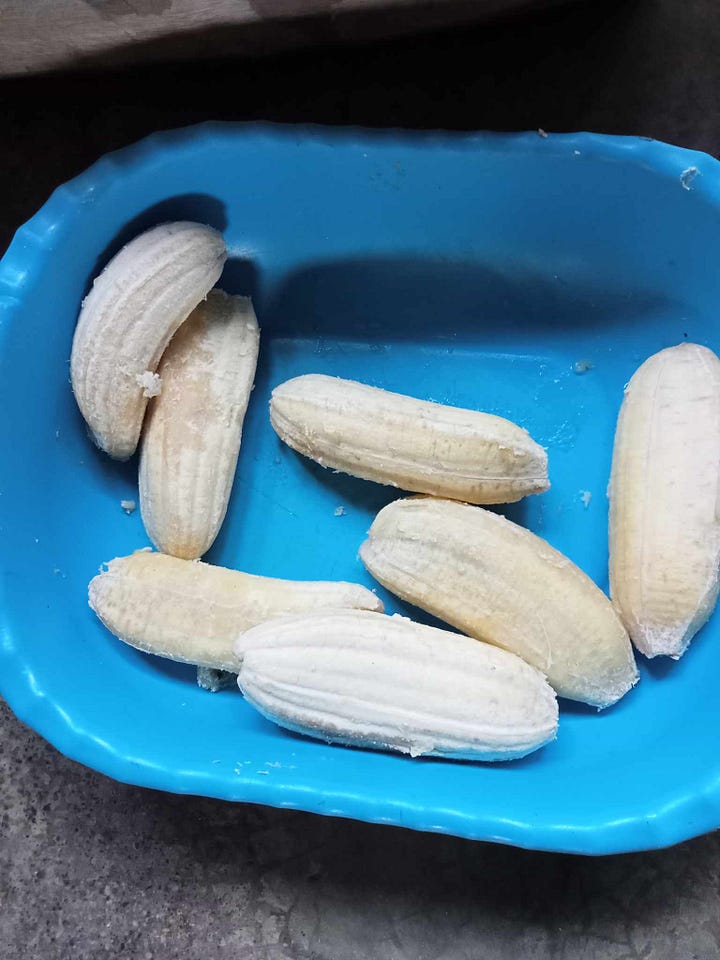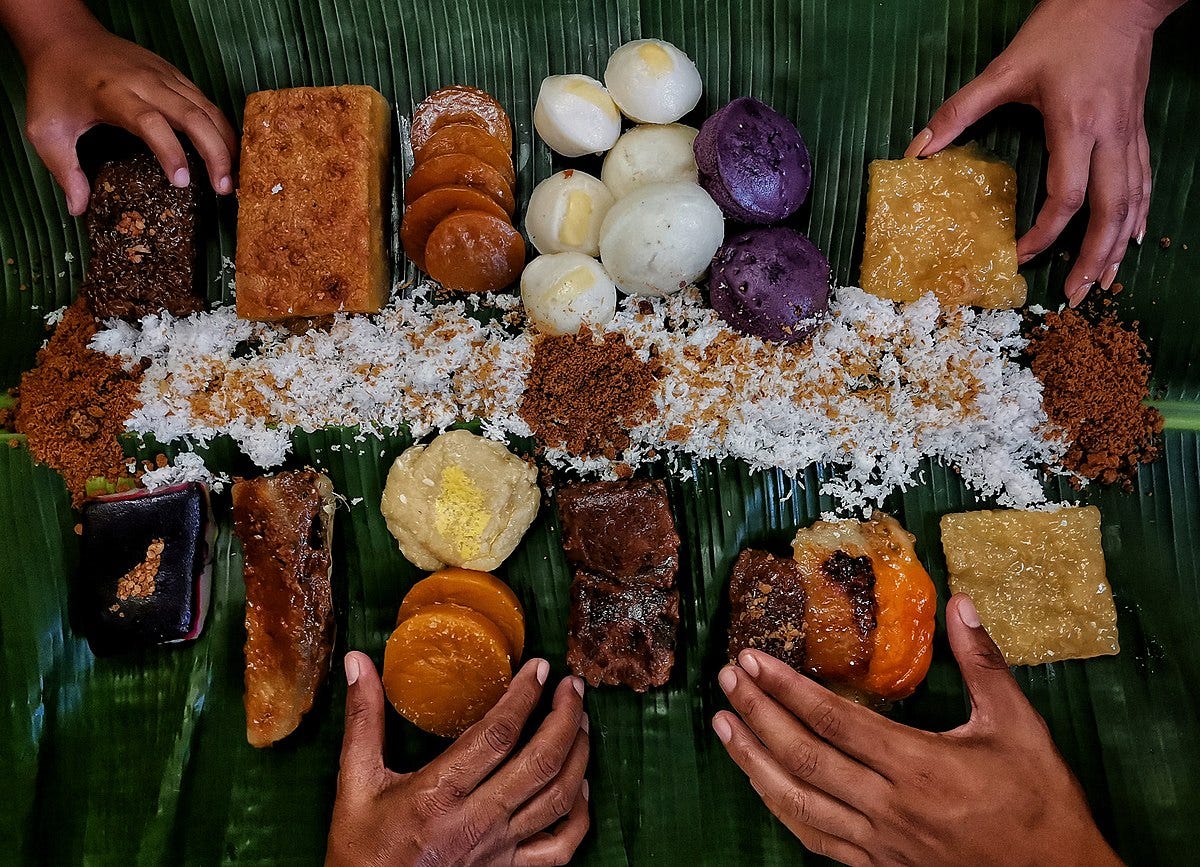Masters of Afternoon Snacks
Anecdotes about our household and the quintessential Philippine snacks
On a peaceful Thursday evening, as I was about to fall asleep so I could get up bright and early for my endless Friday work meetings, I heard my phone’s familiar “ding”. Since it was late, I originally intended to ignore it but then came, “ding! ding! ding! ding!”, which meant it was either my mother or my sister sending me messages about something important (at least, from their perspectives).
“Jocelyn decided to make “nilupak” today. Your favorite.”
I reached for my phone with the intention of just reminding them of our thirteen-hour time difference when I saw what the messages were. I was right. It was my mother and she sent me several photos documenting the banana dish that Jocelyn, our house companion, decided to make that day. With the photos was her short message, “Jocelyn decided to make “nilupak” today. Your favorite.”
Below are the images that my mother sent me that day.
I am posting these with her permission.
In the image, you will see Jocelyn, otherwise known as,
the mastermind of snacks in our household.




These photos reminded me of how much our mom loves snacks. The snacks they usually prepare back home are homemade, with majority of the ingredients gathered from our farms. As I scroll through her photos, I realized how special and also different my childhood was. It could be a case study for the slow-living that tend to be fashionable nowadays.
Filipino Snacks
Filipinos eat snacks in-between meals. In the provinces, the first meal of the day (breakfast) called “almusal” or “agahan” is usually eaten around 6:00AM to 8:00AM. For farmers who are awake early to start toiling their fields, breakfast is eaten before the sun rises. For teenagers who stayed up the night before to watch television or doom-scroll on social media, it would be later.

Lunch or “pananghalian” is typically eaten at noon. Students and company employees take their lunch breaks from 11:00AM to 11:30AM and are free until 1:00PM to 1:30PM (give or take several minutes). The first snack of the day, then, happens between the breakfast and lunch meals. In the afternoon, around 3:00 is when Filipinos typically start searching for their mid-afternoon snacks. This is to tide their appetites until the last meal of the day, dinner or supper (“hapunan”) which is usually around 6:00PM to 8:00PM.
Philippine snacks consist of dishes, usually made from starchy vegetables and fruits that are slightly sweetened (not the American-level of sweetness, though). It could also be one of the many (as in many) forms of sticky-rice cakes sweetened with cane sugar (like “jaggery” for Indian dishes) and cooked in coconut milk. The most popular drink to have with these snacks are coffee, black tea, water or fruit juices for the children (ok fine, soda too).
Another “ding!” came and I saw that my mother sent me a short video clip as well (uploaded with Jocelyn’s permission):
About Jocelyn
She’s been with us since… forever. We’ve seen her get married, have children, and we’ve witnessed her children grow. Whenever I am home, I see those kids riding the same swing set that was the biggest adventure of our young lives. There was a time when she paused being one of our employees to care for her family, but whenever I am home, she comes in to prepare my favorite snacks. “Nilupak na saging” (mashed or pounded sabá bananas with grated coconut) is one and another is “balinghoy” or her steamed grated cassava which she steams inside coconut shells.
While I am grateful for the snacks that she lovingly makes for me and my family, I am more thankful about her presence in our lives. With or without these dishes, she is part of the family and so are her children. I am thankful for her being there for my mom when we are not constantly around and for always being creative about the dishes she would make for the household.
When I went home in 2019, my mom tasked Jocelyn to make “atchara” (pickled papaya or papaya relish) while she was running errands in town with my sister. Since I was the only one left home, Jocelyn shyly came up to me and asked, “Do you remember your mom’s measurement for her “atchara”, Ate Jen?”. She was calling me “ate” (older sister) because I am older than her. I told her I can season the “atchara” for her. She looked at me suspiciously and said, “Are you sure you know the measurements? We might get in trouble if it is wrong. This is planned to be served tomorrow for the party. I know you do not cook.” I laughed so loud hearing her say that and so I explained to her that in America, there is no Jocelyn and others to help me with things at home so I had to learn it all. The next thing she said made me laugh even louder, “Then why don’t you just take me with you when you return to America?”, to which I responded, “If it were that easy, I would have done that since day one.”
I seasoned the “atchara” for Jocelyn and I went back to the garden to read my books. After an hour, she approached me again and reported, “You actually did it correctly, I just tasted it.” I told her, “I am glad I passed your standards, Jocelyn.”
When my mom and sister came back from town, I heard her reporting to both of them loudly that I helped her season the “atchara” and of course, my sister (a professional chef) had to test it too to make sure it was done properly to be served for the party the following day. My mom admonished them by saying that she taught me how to make “atchara” when I was younger, of course I knew how to season it properly.
Mommy
There are many, many, many things I could write about Mommy and our adventures together. Today, I reminisce about the “yema” (Filipino sweet custard confectionary) that we would cook together and pretend that I was building my Yema Empire by selling it to our warehouse workers and my grandparents. The truth was, it was just my grandparents and my mom who purchased everything from me and there I was, so amazed at “how rich” I was with the bills in my pockets.
“Turon” (sabá banana and jackfruit sugar-coated, wrapped, and fried in egg-roll wrappers) is another snack that I typically request to be ready as soon as my flight lands at the airport. It’s either Mommy or my sister who would have our staff prepare it for my arrival. Another is “Puto Balanghoy or Balinghoy” (grated and steamed cassava and coconut) that is super-lightly sweetened and served with black native coffee.
Lastly, “nilupak na saging” (in the photos and video), which has always been very nostalgic for me not just because of the dish itself but because of the memories I have about it including the traditional wooden mortar and pestle that are used to pound it to its desired consistency.
About that vintage mortar and pestle
When I was a little girl, we would take whatever needed grinding or pounding to Tatang Idrong, our grandfather’s cousin, who owned a vintage stone mortar and heavy wooden pestle. Tatang Idrong and his wife, Nanang Kidya, lived next to our house and we would visit their home to hear some amazing anecdotes about their lives during the Japanese time (the second World War). Usually, we would ask them to grind just about anything for us. I would sit there in amazement as I watch Tatang (“father” in the Ilocano language) grind freshly-roasted coffee beans into powder form that my grandmother would then store for our household coffee supply. Home-roasted robusta coffee beans was the staple and it was served to everybody, including all of the workers in the farms. No wonder I am a coffee snob.
The point is…
As I look back and remember details from my childhood, I gain renewed appreciation about how my elders have raised me. I also realize that what we thought of as simple, slow, and traditional are commodities and lifestyles that tend to be valued highly in other parts of the world - especially today.
In my teenage years, I could not wait to get out of there to live my life in the fast-paced modern metropolis. Then, after that, I wanted more. I wanted to get out of the country and to live somewhere far and foreign. I wanted to test my wings and go on my own adventures.
Today, my life seems to have come in full circle. After dozens of cities visited around the world, I now relish the lifestyle, the people, the farms, the food, and the simplicity of the world that I ran away from. My sister would surely tell anyone that I would not survive living there again. She’s probably right. I probably would not live there permanently again. The truth remains, however. And, that is, I now have a different appreciation of everything provincial and Philippine-style.
Thank you 🙏 for the pictures, Mommy and Jocelyn!
How about you?
🥮 What were your favorite snacks from your childhood?
🍡 What types of food make you think of home?
Series: 🇵🇭 Filipiniana: Writings about my own culture
Curious enough? Here is a 📺 video from Yummy Kitchen TV Youtube Channel





For a time, my mum was an assistant cook in a secondary (11-16 year olds) school. Two recipes that she downsized were spaghetti bolognese, and sweet and sour sauce. They were written on paper towels. I’ve still got them somewhere, and have used them myself. I think I was in my final year or two of primary when she worked there, so would have been 9-10 years old (1976-77).
For snacks, it has to be biscuits called melting moments. They are soft, but not chewy, technically not really a biscuit at all, but not cakes, either. They have desiccated coconut coating, with a glacé cherry on top.
I found this fascinating. An insight into the childhood of another is always interesting. It is good to return home every now and again to step back into a steadier pace of life.